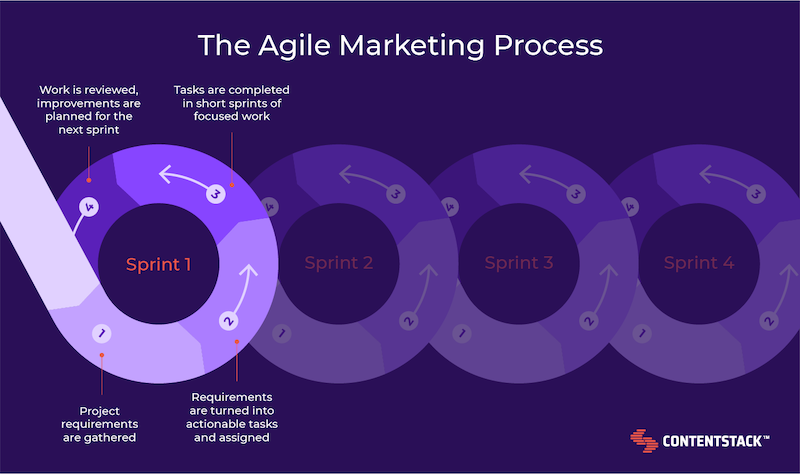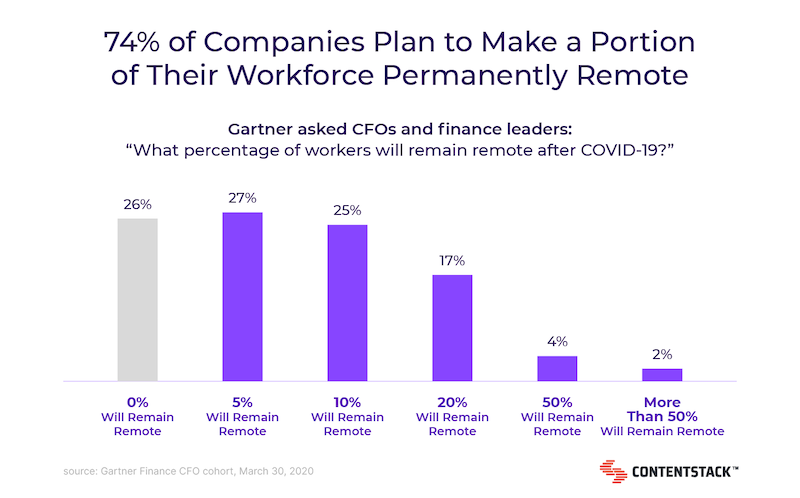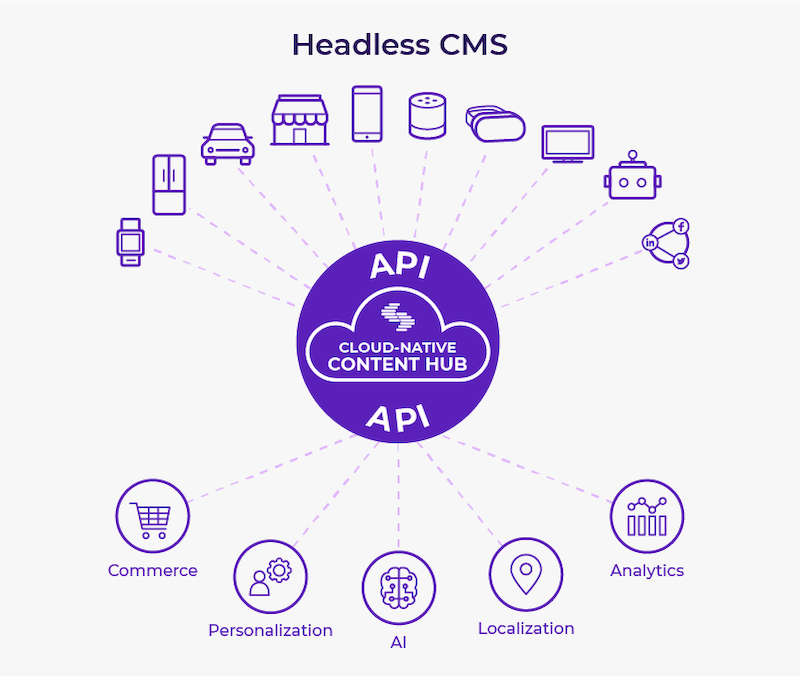Think Agile To Extend the Value of Content Systems and Processes

Chief Marketing Officers (CMOs) have the highest turnover of all C-suite roles at Fortune 500 companies. The executive search firm Spencer Stuart found that the tenure of CMOs at top U.S. brands in 2019 averaged 41 months. The median tenure was just 30 months.
Why?
“Tough business headwinds, new technologies, and pressures to change quickly,” said Greg Welch, a Spencer Stuart consultant. “It’s a perfect storm.”
In a business environment — and the world — where change is the most reliable constant, CMOs, their teams, and the departments with which they partner across the organization must become agile to keep up. The word “agile” is becoming a keystone term for marketing and content management. Forrester has redefined the CMS category to “Agile CMSes” and recently released the “Forrester Wave™: Agile Content Management Systems (CMSes), Q1 2021” report.
The following explains what agility means in marketing and content management, why now is the time to adopt agile methodologies and a three-step strategy for developing a winning agile marketing program.
What Does Agile Marketing Mean?
Traditional marketing methods follow a waterfall approach, where large projects “flow” from one completed task to the next — from planning to writing, then design, then legal, and so on. etc.
The problem with this approach is that it doesn’t leave room for unforeseen hiccups that often happen along the way. Since each step can become a bottleneck that stops work for everyone downstream, the waterfall approach puts marketing campaigns at risk of running over budget or losing relevance by completion time.
Agile marketing methods, on the other hand, are based on the popular agile software development methodology. At their core, agile projects call for constant prioritization, collaboration, and iteration to complete bite-sized tasks. An agile marketing approach empowers multi-faceted teams to collaborate on small pieces of large projects over short intervals of time known as “sprints.” This process allows agile marketing teams to keep putting out new and relevant campaigns that they can regularly come back to and improve over time.

Why It’s Time to Adopt Agile Marketing
Even before COVID-19 changed the world, “business as usual” was already getting a little less usual. The number of U.S. employees who telecommute at least half the time grew 115% between 2005 and 2017. And as of mid-April 2020, 62% of employed adults in America worked from home due to COVID-19. About half of these workers said they’d prefer to continue to work remotely if possible. And they might get their wish, considering that three-quarters of companies are planning to keep some percentage of their workforce remote even after COVID-19 is under control in their areas.

This shift has required organizations to adopt agile processes, policies, and technologies that empower collaboration and productivity for their distributed marketing, IT, and other departments.
In addition to newly-remote workforces, there’s another major shift driving the need for agile marketing. Today, the way consumers shop is channel-agnostic and concurrent. Consumers themselves are agile. Modern consumers interact with six brand touchpoints on average before making a purchase. This interaction wouldn’t be so overwhelming if they didn’t expect that their experience will be seamless across each touchpoint.
The vast majority (90%) of consumers report finding personalized experiences appealing, 80% say they’re more likely to do business with a company that personalizes their experience, and 75% of consumers are downright frustrated by irrelevant marketing.
What does an organization need to do to process data and produce the level of content necessary to provide a personalized, omnichannel marketing experience for every last consumer? Employ an agile marketing program.
A Three-Part Strategy for Developing an Agile Marketing Program
This three-part strategy will help you develop the processes and choose the tools you need to move with agility when it comes to managing a distributed marketing team, producing high-quality campaigns, and optimizing them for various audiences and distribution channels.
Start with a Solid Structure: Think MACH-First
“MACH” describes technology that is microservices-based, API-first, cloud-native, and headless. Microservices ensure a marketing platform can adapt to fit every change the future holds. Application programming interface (API) technology enables countless integrations and seamless content delivery. Meanwhile, cloud-native infrastructure means your marketing platform is always up-to-date and ready-to-scale. A headless architecture empowers streamlined content operations so you can quickly optimize your campaigns for each audience and channel.
A marketing platform built following MACH principles empowers marketing teams to collaborate, create, test, learn, and improve — fast. A MACH-first marketing platform is, at its core, agile. And speaking of this “marketing platform,” it all starts with the right software.
Adopt the Right Software: An Agile Content Management System
Creating an agile marketing program requires adopting an agile content management system (CMS) to keep up with and empower your modern marketing efforts.
The problem with the traditional, monolithic CMS platforms (like WordPress and Drupal) to which many organizations are still tied is that content and its presentation are intertwined. This coupling of content and the presentation layer means you have to manually recreate content each time you want to use it for a new customer type or channel. It’s easy to see why traditional CMS is not agile enough for organizations that need to quickly develop and deliver a variety of personalized, omnichannel campaigns.
On the other hand, a headless CMS separates content creation and presentation. This separation enables marketing teams to create content-powered experiences. Simultaneously, designers and developers build out the best displays for these campaigns — whether they’re delivering content to websites, mobile apps, email campaigns, chatbots, or elsewhere. It enables agility.
The APIs that power a headless CMS’s modular architecture also make it easy to integrate with microservices — such as CRMs, DMPs, ecommerce platforms, translation and localization tools, AI-powered analytics programs, and more — to automate best-in-class content optimization and delivery.

Implement Your New Process: How to Deploy an Agile Marketing Workflow
With your structure and software in place, the final step is to implement your agile marketing program.
Here’s a quick rundown of the steps to deploying an agile marketing workflow:
- Win stakeholder buy-in. Consensus is more important than ever when it comes to agile projects because goals can shift regularly, and it isn’t always easy to see progress when changes are happening quickly but on a small scale.
- Create your project roadmap. Of course, you should expect some dates to change due to the always-evolving nature of agile projects. However, try to define the significant milestones, if only to keep stakeholders happy and everyone else accountable.
- Never stop talking about the “big goals.” The small goals may change along the way, but you’ll still need to meet the big goals that helped you get buy-in in the first place. Remember that you should break down every goal into short, actionable tasks that you can complete within a sprint cycle.
- Round up your resources. With big goals, small tasks, and everything in between figured out — it’s finally time to invest in the resources (tools, training, etc.) that you’re going to need to get it all done. This is the time you want to shop for your agile headless CMS.
- Start small. Don’t expect your first agile marketing campaign to go totally according to plan. Treat your marketing program just like you would any agile campaign—start with what you know, learn, improve, and then grow.
Kick-off Your Agile Marketing Program with a Big Win
Forrester’s definition of agile CMS — “a solution for collaboratively curating, creating, and delivering content across channels and campaigns via iterative development and deployment processes” — further cements agile, headless CMS as the central platform which you need to build a modern marketing program.
For more information on why transitioning to an agile CMS saves companies time, money, and headaches, while empowering business and technical users, check out Contentstack’s “Marketers and Developers Embrace Agile CMS” webinar featuring Nick Barber, Senior Analyst at Forrester.
At Contentstack, we’re proud to be recognized among the top agile CMS providers. And we invite you to start your new agile marketing program off on the right foot with a free, no-obligation, 30-day trial. Try our features, set up a proof of concept, and see why our Contentstack’s agile headless CMS is a big win for your modern marketing program.
About Contentstack
The Contentstack team comprises highly skilled professionals specializing in product marketing, customer acquisition and retention, and digital marketing strategy. With extensive experience holding senior positions at renowned technology companies across Fortune 500, mid-size, and start-up sectors, our team offers impactful solutions based on diverse backgrounds and extensive industry knowledge.
Contentstack is on a mission to deliver the world’s best digital experiences through a fusion of cutting-edge content management, customer data, personalization, and AI technology. Iconic brands, such as AirFrance KLM, ASICS, Burberry, Mattel, Mitsubishi, and Walmart, depend on the platform to rise above the noise in today's crowded digital markets and gain their competitive edge.
In January 2025, Contentstack proudly secured its first-ever position as a Visionary in the 2025 Gartner® Magic Quadrant™ for Digital Experience Platforms (DXP). Further solidifying its prominent standing, Contentstack was recognized as a Leader in the Forrester Research, Inc. March 2025 report, “The Forrester Wave™: Content Management Systems (CMS), Q1 2025.” Contentstack was the only pure headless provider named as a Leader in the report, which evaluated 13 top CMS providers on 19 criteria for current offering and strategy.
Follow Contentstack on LinkedIn.






.svg?format=pjpg&auto=webp)
.svg?format=pjpg&auto=webp)
.png?format=pjpg&auto=webp)






.png?format=pjpg&auto=webp)


